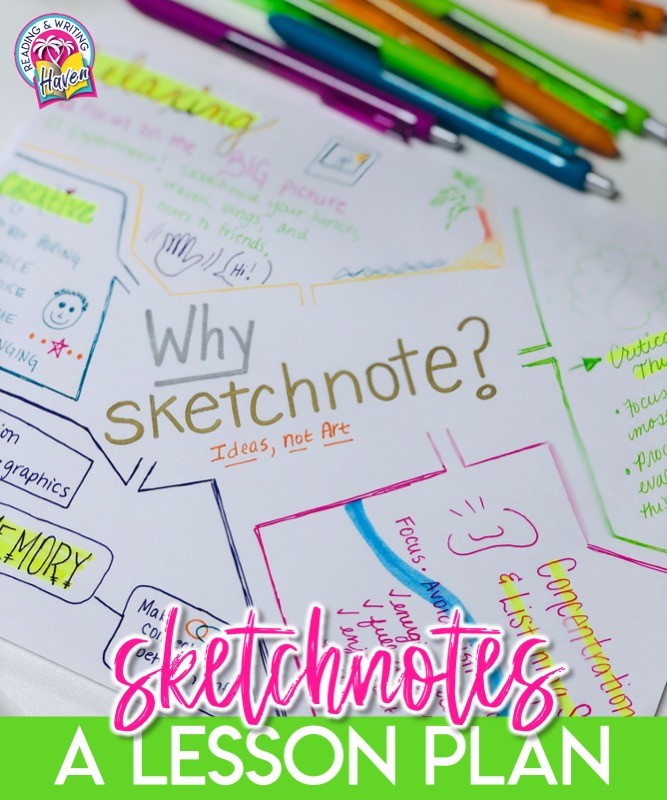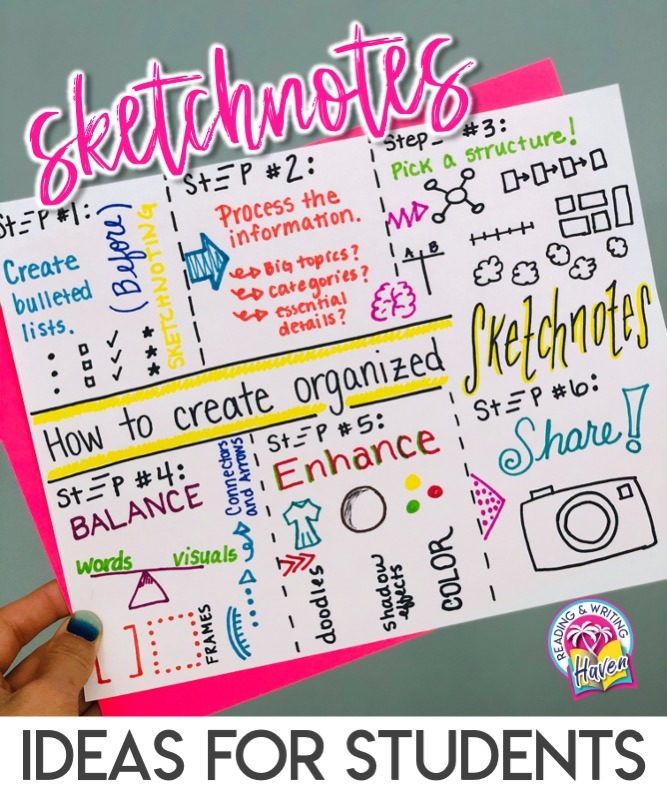How to Get Started with Sketchnotes in the Classroom
So you want students to do something…to show thinking…to process learning…and to communicate information. But, maybe you’re tired of recycling the same approaches and just need something refreshing. Enter sketchnotes. Perhaps you’ve seen them? Using sketchnotes in the classroom can be powerful.
This strategy gives students voice and choice. Plus, it hinges on metacognition, reflection, and critical thinking. When I first began exploring sketchnotes, I was curious, but hesitant. Where would I even start?!
In this post, I’m walking you through how I dipped my toes into sketchnoting. I hope you find this lesson plan helpful if you’re wondering how to get started.
STEP 1: Research it.
I’ve always been a doodler. Sketching in my notes is not new to me. But, doodling to doodle is not the same as sketching with meaning.
In order to introduce sketchnotes to students, teachers first have to possess a fairly good idea of what they are. To wrap my brain around sketchnotes in the classroom, I asked hard questions and did some preparation work.
Visuals. What can sketchnotes look like? What elements does a “sketchnoter” use when creating? In filtering through examples from the web, I began to develop a conceptual understanding of possible appearances. At first, I was confused. Sketchnotes seemed very similar to one pagers. This question led me to researching their purpose.
Purpose. The purpose is for students to process their thinking, and the audience is – the student! While students may spend a couple hours perfecting a one pager so that a teacher can evaluate learning, that same intensity is not inherent with sketchnotes. Students create them FOR themselves. They can help students to listen more intently, to study or review, and to teach others about a topic.
Timing. So then, I began to wonder…when does it make sense to use sketchnotes in the classroom? Here are some examples, but the list could be much longer. Sketchnotes can be a…
- way to take or synthesize notes
- listening activity during discussions (make listening visible!)
- strategy to organize pre-writing
- response-to-reading approach
- study tool to show how concepts are related
- spicy addition to journal responses
You may find it helpful to introduce sketchnotes as a possible notetaking strategy, among many others.
STEP 2: Try it.
You will not be “comfortable” with sketchnotes until you try them! Even after using them on and off for over a year, I don’t feel like any sort of expert when creating them. But, I think that’s the point we need to embrace.
When I make sketchnotes, I have to keep reminding myself — perfection is not the goal. To model my vulnerability and ongoing learning with this strategy for students, I sketchnote in front of them. Do it on the white board, on anchor chart paper, or digitally using a program like Explain Everything or Notability.
Creating sketchnotes yourself will help you to anticipate questions students will have, and it will prepare you to give them practical advice.
STEP 3: Teach it.
If you’re overwhelmed by not knowing how to begin using sketchnotes in the classroom, the best thing to do is just dive in. Students are open to learning new things as long as we frame the value.
I know that it can help to see how other teachers have introduced this notetaking strategy to their students. So, I’ll walk you through my approach. Keep in mind — there are countless ways this can be done! Hopefully, in sharing my learning, you will find some inspiration that will work for you.
Frame the Value
What are they? I begin by defining sketchnotes: Using quick sketches alongside short phrases to help you better remember and/or share what you are learning… or… Notes that communicate information using WORDS & VISUALS.
I also show them some examples of sketchnotes…both elaborate and basic. One of the biggest oppositions I hear from students about sketchnoting after I first introduce the strategy is, “I can’t draw.” You can address this statement in a couple different ways.
First, you don’t have to be able to draw. If students enjoy doodling, their sketchnotes might be doodle heavy. But, if they prefer to take notes with words, their sketchnotes might just include visuals that help to organize and connect the information (boxes, containers, arrows) rather than doodles.
Secondly, I tell them that everyone can doodle, but it isn’t required. You can sketchnote without drawing.
Why sketchnote? We talk about the learning value of visuals and how doodle associations can enhance our learning. I also have showed this video to students. I pause it (because it moves quickly!), and by the end, they have all drawn a few pictures.
Sketchnotes in the classroom are relaxed! The format isn’t strict, and it’s a custom note-taking process. Students have the freedom to create sketchnotes that work with their learning style and personality.
This strategy keeps students focused, makes thinking visible, targets higher-level thinking, and emphasizes creativity.
Start Sketching
Pre-Sketching Work
Day 1: If you have time, I have found it helps to give students a day to play around with sketchnoting concepts, like creating containers, arrows, shading, doodles, and font types. Give students a task (for instance, playing with different writing utensils or using mood to sketch words in symbolic ways), and set a timer.
Day 2: (Note…days do not have to be consecutive!) To start sketching, it’s easiest to find a quick text or short podcast. I have used both a video clip and a song. I wanted something where students would have to LISTEN and not focus on written words. Most recently, I used Carrie Underwood’s The Champion song.
Because some students have a hard time creating sketchnotes on the spot (I do, too!), it is helpful to have them listen and make a bulleted list of thoughts that come to mind.
What…
- do you think?
- questions do you have?
- visuals pop into your mind?
- words stand out?
- connections can you make?
- is the main point or theme?
Once we have listened and created a bulleted list, we talk about how to organize ideas into sketchnotes. This is when we dive into common structures and visual components. Students can create webs, mind maps, flow charts, timelines, and so much more. In essence, they are creating their own unique graphic organizers.
Higher-order thinking is involved here because students have to choose a structure for their sketchnotes that best fits the information they want to convey. This is also metacognition in action!
During-Sketching
Next, we listen to the song a second time. Using big paper at the front of the room, I begin to create sketch notes as the song plays. This is vulnerable work. My sketchnotes are often childish looking. But, it’s important for students to experience that the value of sketchnoting is not in the quality of the drawing. Rather, it’s in the mental energy involved in processing information, synthesizing and connecting ideas, and representing learning through symbolic structural and visual elements that elevate thinking.
STEP 4: Reinforce it.
When introducing sketchnotes in the classroom, it’s important to remember that after a single modeling lesson, students won’t be ready to fly solo. In order for sketchnotes to stick, we have to periodically embed them into our mini lessons and whole class or small group activities.
Once students have built up enough confidence with sketchnotes (you’ll see them creating sketchnotes voluntarily or beginning to sketch first instead of creating the bulleted list of notes), you can offer it as an option in pretty much anything you do for the remainder of the year.
Discussion prep? Reading notes? Study guide? Podcast listening activity? Learning station work? Yes to all of these and more.
STEP 5: Provide Feedback.
I don’t believe in grading sketchnotes because I think it adds a layer of negative energy around an activity in which students are already offering some vulnerability. Yet, that doesn’t mean I don’t provide feedback, and if your assessment of sketchnotes is based off of demonstration of standard proficiency, it would make sense to “grade” the work.
Types of Feedback
Teacher Feedback: Students value feedback, and we can motivate them by continually nudging them along the sketchnote learning continuum. Creating a comment bank, learning progression, or rubric can make feedback efficient.
Self Asssessment: Students can also evaluate their own sketchnotes based on a set of criteria you establish. It’s best to align the criteria to whatever standard or skill you are asking them to develop. Some ideas include summarizing, challenging biased ideas, building on ideas, and using textual evidence to support thinking.
Peer Feedback: Display examples of student sketchnotes in the classroom or online. Schoology, for example, has a media album where students can upload a picture of their work, and other students can comment on it to provide peer feedback.
Make time for students to analyze one another’s sketch notes. They will have such valuable takeaways just from seeing how their peers processed information differently than them.
When providing feedback, make sure any comments focused on visuals are regarding a demonstration of learning. For example, it would be helpful to say, “The way you used larger bubble letters to represent main categories from the reading is helpful for showing how your brain organized the information.”
However, it’s not helpful to focus on the aesthetic elements just because they are pretty. For instance, “These are stunning!” doesn’t really provide any feedback on standards learning, and it conveys the wrong message. Beautiful notes do not trump quality notes. And, it might intimidate students who aren’t putting as much effort into the artwork of their sketchnotes as they are the content. As sketchnote pioneer Mike Rohde advises, “Make ideas, not art.”
Helpful Resources for Using Sketchnotes in the Classroom
Many people ask for resources. If you’re looking for helpful tools for your own reference or to share with students, I’m happy to share my Pinterest board with you. This is where I save examples and references that deepen my understanding of and challenge my thinking about this instructional strategy.
If you’d like additional sources and ideas for getting started with sketchnotes in the classroom, you would probably like:
The world is going visual. By sharing a fresh and creative notetaking strategy with the next generation, we’re equipping them with abstract, critical thinking skills. I hope these resources and the ideas in this post empower you to dive into sketchnotes in the classroom. While at first it may feel intimidating, you CAN do this. You don’t need all the answers. Students will appreciate the opportunity to learn alongside of you.
And, above all, let’s give ourselves some grace. Sketchnoting should make learning fun. If you sense students are feeling more stress than fun, it’s time to re-evaluate the approach.
Sketchnotes in the Classroom: Resource
If you are ready to give sketchnotes a try but short on time to prepare a lesson, this resource contains everything you need to make the approach I’ve written about in this blog post happen.
Click on the image to start your sketchnote journey with students!





